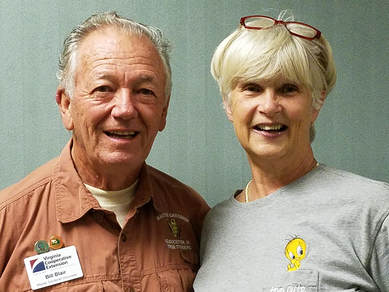 Bill Blair (left) and Daina Henry (right), two of our 2017 statewide award winners.
Bill Blair (left) and Daina Henry (right), two of our 2017 statewide award winners.
In 2017, we expanded our awards into eight different categories. We very much thank all of the people who took time to write and submit nominations for these awards. Details on this year’s winners are below.
Volunteer With the Most Hours
This award recognizes the volunteer who reported the most hours in the previous year. The recipient, Daina Henry (VMN-Peninsula Chapter), completed and reported 1,087 hours of Virginia Master Naturalist volunteer time in 2016. That is just about the hours of a half-time job! In 2016, Daina conducted water quality monitoring in local streams, organized a biodiversity inventory of a wetland and creek area, assisted with trail maintenance for a nature trail used by school groups and the public, and participated in several education and outreach efforts in the community. She also served as the president of her chapter.
Volunteer of the Year
For the Volunteer of the Year, we received 11 nominations of volunteers from 11 different chapters. Every single one of these people, as well as many who weren’t nominated, is truly a Volunteer of the Year. It is amazing what these individuals give to improving natural resource education, stewardship, and citizen science in their communities. We want to recognize all of the nominees, along with this year’s winner.
The award for Volunteer of the Year goes to Bill Blair (VMN-Northern Neck Chapter), a volunteer who exemplifies the leadership we hope to see from Virginia Master Naturalists. His nominator writes, “His energy, positive attitude, subject matter expertise, and communication skills have had a clear and measurable impact on motivating people to learn about and embrace the natural world and volunteer. His volunteer work defines what it is to be a selfless Master Naturalist to better the Commonwealth of Virginia.” Examples of his ongoing work in include volunteer projects at Belle Isle State Park Youth Camp, Leading tours and educational programs at the Virginia Institute of Marine Science (VIMS), leading several bird survey projects, providing stewardship work at two local parks, and even performing a re-enactment of John Muir and his legacy of conservation.
“In addition, he has been a mentor and coach to our BTC and to help members of the chapter get involved in new projects that might be outside of their comfort zones. Not only is he a life-long learner but he helps nudge along many in our chapter to learn new things, try new projects, master new skills, support more youth programs, and partner with other organizations.” –Nominator, writing about Bill Blair, VMN-Northern Neck Chapter
|
Name
|
Chapter
|
Nomination Highlight
|
|
Jennifer Ambs
|
Pocahontas
|
“One attribute that stands out is Jennifer’s creative thinking. Jennifer Ambs is an exemplary volunteer in following her passion and living every day as an adventure.”
|
|
Margaret Chatham
|
Arlington Regional
|
“Margaret possesses an amazing amount of Virginia native plant knowledge and she readily shares her expertise with anyone with an interest. She gives exacting information while encouraging participants to fully appreciate the native flora of Virginia. Margaret also gives engaging botanical lectures that help deepen her audiences’ understanding of the somewhat technical material.”
|
|
Marian Childress
|
Tidwater
|
“Let it be known that surpassing 5000 volunteer hours as a Virginia Master Naturalist has demonstrated an uncommon dedication which exemplifies an ethic of selfless passion and commitment to serve as an environmental ambassador educating the public about and protecting our magnificent marine animals and their conservation needs.”
|
|
Robin Duska
|
Fairfax
|
“Robin was one of six Virginia Master Naturalists on an EAC working group that produced the first Reston Annual Environmental Assessment Report. She was lead author of its Birds, Mammals, and Light Pollution chapters and served as my co-editor for which she did a tremendous job of making the contributions of nine citizen scientists read as one in the final 172-page report. Without question, Robin was the hardest working member of the EAC working group for which I served as Project Director.”
|
|
Les Lawrence
*HONORABLE MENTION* |
Historic Rivers
|
“As members from new cohorts join the group, he makes each feel welcome and lets everyone know that their contributions are appreciated, even though they might not feel confident yet in their knowledge. Yet, at the same time, he also freely acknowledges and commends our very skilled bird, plant, and reptile identifiers. His patience, kindness, natural curiosity, and love of Nature permeate any project that he leads or of which he is a participant, be it bird counts, butterfly counts, oyster conservation, or board membership.”
|
|
Alex Newhart
|
Shenandoah
|
“With full classes each year, Alex has worked tirelessly to incorporate new ideas, focus on the best pedagogy for adult learners, engage exciting new speakers, and tip the balance of training programs towards experiential learning in the field.”
|
|
Jack Price
*HONORABLE MENTION* |
Old Rag
|
“Although Jack had little experience as a naturalist in positions prior to his retirement he quickly educated himself and began instructing others. He has taught subjects on forestry, botany, and ornithology to trainees in every one of the eight classes. Because he is highly regarded as an effective teacher, organizations frequently invite him to speak on environmental subjects and issues. He is always ready and willing to volunteer for these events when asked.”
|
|
Regina Prunty
|
Central Rappahannock
|
“Regina was our founding Chapter Advisor, and it was her vision that got us started. The best quality Regina has, is that she is a good friend to everyone she meets and in the volunteer world that moves mountains.”
|
|
Marilyn Smith
|
Rivanna
|
“In the true spirit of volunteerism, Marilyn never seeks the limelight for herself; she would rather recruit someone as a new volunteer to a project of hers than to talk about how hard she has worked on that project.”
|
|
Susan Walton
|
Peninsula
|
“Susan Walton did an incredible job planning, coordinating, funding and implementing with great success a program for ALL fourth grade students in Gloucester to attend Beaverdam Park in order to experience nature, water quality testing, the water cycle, and the nature the park had to offer.”
|
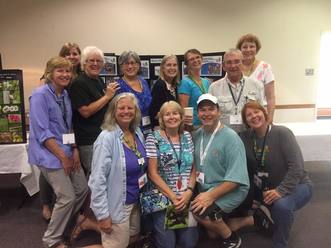 VMN volunteers from the Historic Rivers Chapter gathering at our statewide conference in September.
VMN volunteers from the Historic Rivers Chapter gathering at our statewide conference in September.
Our chapters vary greatly in size, so for this award, we scale the hours based on the total number of volunteers in the chapter who reported service hours that year. Winning the award for their 2016 work this year is the Historic Rivers Chapter, one of our larger chapters, with 118 active members in 2016. On average, those volunteers each contributed 134 hours of service during the year. Some of the projects they did included wildlife monitoring through DGIF’s Wildlife Mapping project (done as an organized group in local parks), numerous bird and butterfly counts, environmental education with local parks and schools, and oyster restoration projects.
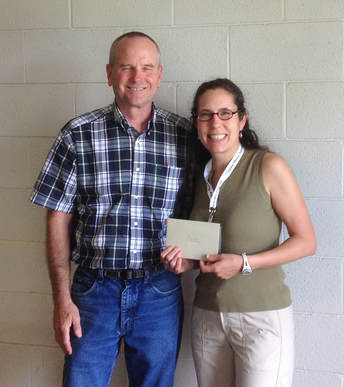 Paul Bugas receiving Chapter Advisor of the Year award from Michelle Prysby, VMN Program Director.
Paul Bugas receiving Chapter Advisor of the Year award from Michelle Prysby, VMN Program Director.
Each of our chapters has a chapter advisor who works with one of the seven state agency sponsors of the program. Our 2017 Chapter Advisor of the Year is Paul Bugas of the Headwaters Chapter. Paul is a Fisheries Biologist with DGIF. His contributions have included sponsoring the original organizers of the chapter, arranging for chapter outings and continuing education opportunities, nurturing the chapter through various growing pains. The nominator writes, “Our project list and volunteer participation levels are still a reflection of his positive influence, as we are motivated to live up to his trust and example. He is there at night and on weekends for graduations, tours, annual meetings, and individual member needs. And he is not just there – he will bring a casserole too! Because of Paul, the Headwaters Chapter members will continue to volunteer for chemical and macroinvertebrate river monitoring, river cleanups, school and public education days, riparian buffer planting and maintenance, and many other projects. We honor his investment in us!”
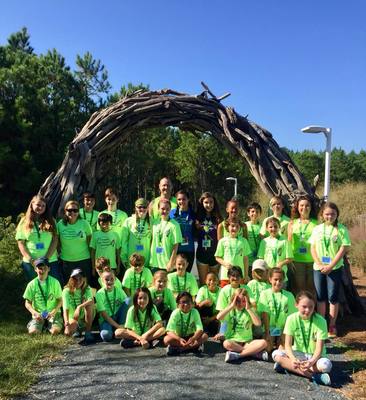 2017-2018 Virginia Junior Master Naturalists with the Tidewater Chapter.
2017-2018 Virginia Junior Master Naturalists with the Tidewater Chapter.
The Virginia Junior Master Naturalist Program of the Tidewater Chapter connects youth to nature through a creative model of training teen leaders who then develop lesson plans and lead learning sessions and field activities for 8-13 year old children twice a month. The program also pairs other Certified Virginia Master Naturalists from the chapter with the teen leaders to help provide mentorship, and members of the chapter also serve as guest instructors or helpers for the activities. The intention of the program is to help youth grow from participants to teen leaders to future Virginia Master Naturalist volunteers. Two VMN volunteers, in particular, have really made this program happen: Suzanne Moss and Jody Ullmann. They taught a session about their program at the VMN statewide conference in September.
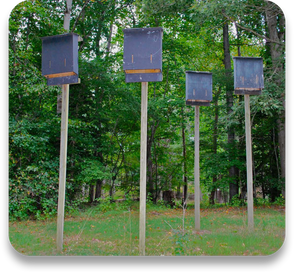 Bat houses at Pocahontas State Park, where VMN volunteers conduct regular monitoring of bat populations. Photo by VMN-Pocahontas Chapter.
Bat houses at Pocahontas State Park, where VMN volunteers conduct regular monitoring of bat populations. Photo by VMN-Pocahontas Chapter.
The Bat Monitoring Project of the Pocahontas Chapter started with a focus on monitoring bat populations in Pocahontas State Park, documenting the existing population and determining locations for additional bat boxes based on weekly monitoring throughout the park. More than 40 members of the chapter have participated in the project. Now, more recently, it is starting to expand to new locations, and they are working to get 12 more chapters involved in bat monitoring using bat detectors and a standardized national protocol. Liz Revette of the VMN-Pocahontas Chapter has been the leader for this entire effort, proposing the original project in the park, contacting other chapters as she works to expand the project, and writing grants to purchase equipment.
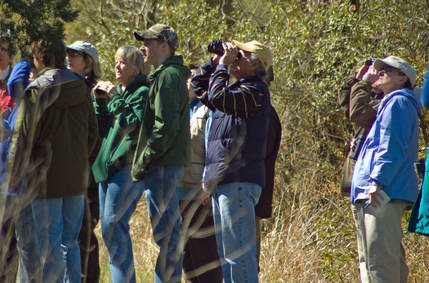 Volunteers from the VMN-Northern Neck Chapter observing wildlife at Belle Isle State Park. Photo by VMN-Northern Neck Chapter.
Volunteers from the VMN-Northern Neck Chapter observing wildlife at Belle Isle State Park. Photo by VMN-Northern Neck Chapter.
Quite a few of our chapters participate in the DGIF Birding and Wildlife Trail Adopt-a-Trail project, in one way or another. The Northern Neck Chapter has turned this project into a major chapter project, monitoring 22 sites for the Northern Neck Trail spread out over some 8,000 square miles. Nearly one-third of their chapter members participate, and they contributed approximately 300 hours to the project in just 18 months. Much of their success is due to the hard work by Alison Sowar, who coordinates the project within the chapter, organizing the volunteers, collecting the data from the volunteers and creating reports, and communicating with DGIF.
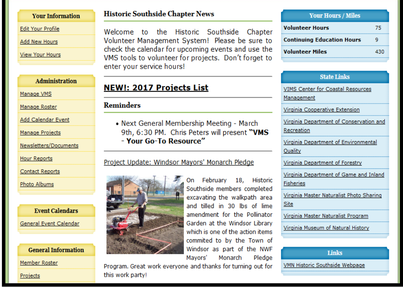 The Historic Southside Chapter re-vamped their volunteer management system pages to highlight current projects with photos and updates.
The Historic Southside Chapter re-vamped their volunteer management system pages to highlight current projects with photos and updates.
Between 15 and 20 percent of VMN volunteer hours are on administration – all that work that keeps our local chapters running effectively. This work is vital due to our program structure; we don’t have any local staff serving as coordinators–just our chapter advisors who provide some oversight. Few people become Virginia Master Naturalist volunteers because they want to work on chapter administration, yet some volunteers really put in effort to go beyond the minimum to make their chapters the best they can be. The selection committee has chosen the Historic Southside Chapter’s “Update of Chapter Projects, Homepage, and Overall Usage and Understanding of the Volunteer Management System” for this year’s award. Early in 2017, Chris Peters, who was a new member of the chapter, volunteered to do research and develop a presentation to enhance the chapter’s use of the VMS. That resulted in a major overhaul of project organization, with reviews and updates of all project descriptions. They also re-vamped the chapter’s home page on the VMS to highlight current projects with photos, in order to encourage members to log on frequently to see what is new. Chris developed a training presentation on the VMS used with both new trainees and the general membership. The chapter has seen a 12% increase in the number of hours entered, and many chapter members have expressed appreciation for the additional training and the upgrades.
